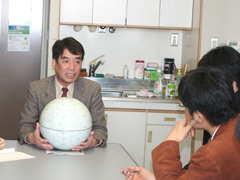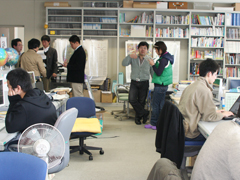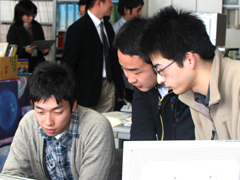Start of Observation Data Analysis Brought by KAGUYA (SELENE)
The University of Aizu has been participating in the "KAGUYA" (SELenological and ENgineering Explorer; SELENE)
project, which was launched by the Japan Aerospace Exploration Agency (JAXA) on September 14 of last year. A research team
centered around the Multimedia Systems Laboratory of the University (headed by Professor Noriaki Asada) is now engaged in
observational data analysis transmitted by "KAGUYA" (Data provision by JAXA and the National Astronomical
Observatory of Japan), to create a comprehensive digital map of the moon.
The research team started full-scale analysis from Friday, January 25, and opened its actual analytic works to the press.
From a perspective of computer science, the University will contribute to the project in processing and analysis of large
amounts of data obtained by "KAGUYA", such as high-resolution images and advanced terrain models, which will reveal
geologic and topographic information of the moon. Through this activity, the University will create a lunar surface GIS
(Geographic Information System) and contribute to the objective of the project; the origin and evolution of the moon.
"Only small number of people can usually participate in such a big project. However, it is my honor to be involved
with the project. I am very excited about the future of this research." said Mr. Naohito Harada, a 2nd-year student
of the master's course, and Mr. Yuto Shibata, a 4th-year student of the Undergraduate also said "I had thought that
space research was far removed from myself, but I was thrilled that I was able to make a contribution to the project."
 Professor Asada at the press conference |
 Scene form the Laboratory |
 Students working on the analysis |
 |
For more information about the details of KAGUYA project, please visit the following websites.
- Official Website of KAGUYA (SELENE)
- http://www.selene.jaxa.jp/en/index.htm
- Official Website of RISE (Research In SElenodesy) Project, National Astronomical Observatory of Japan
- http://risewww.mtk.nao.ac.jp/en/index.en.html
Observational devices with which the University is principally involved, are lunar surface imaging spectrometers (cameras) and a laser altimeter. Please refer to the following links to view their specifications and initial results.
- Laser Altimeter (LALT)
- http://www.jaxa.jp/press/2008/01/20080110_kaguya_e.html
- Terrain Camera (TC) / Multi-band Imager (MI)
- http://www.jaxa.jp/press/2007/11/20071116_kaguya_e.html
- http://www.jaxa.jp/press/2007/11/20071128_kaguya_e.html